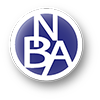I understand your question is about a specific item in the CNIB course UEB Technical. Please allow me to address subscripts and superscripts generally in UEB Math/Science and not just the one item in a course of practice items.
ABC
One way of looking at sub- and superscripts is to talk about three spaces in print. There is space "A," which is the symbol on the baseline. There is space "B," which is the space immediately to the right of A. And space "C" is the space to the right of B. ABC
Transcribing simultaneous sub- and superscripts
Simultaneous sub- and superscripts happen in space B.
If print shows simultaneous sub- and superscripts, then we transcribe first the subscript and then the superscript. (GTM 7.7)
Transcribing non-simultaneous sub- and superscripts
Non-simultaneous sub- and superscripts have one script in B and another in C. In other words, the sub- and superscript are not in print stacked on top of each other in the same space immediately following the baseline letter (or other symbol).
If print shows a superscript in space B and a subscript in space C, then we know to break from the standard order and transcribe first the superscript and then the subscript. We expect the braille user to recognize this break from standard order and so get the information that print gives by putting the superscript in space B and the subscript in space C.
Here's the tricky bit. If print shows a subscript in space B and a superscript in space C, then a braille transcription that follows print without any grouping indicators would look just like the transcription of a simultaneous sub- and superscript.
So, in order to give the braille user the information that print is giving by using non-simultaneous sub- and superscripts, we group the baseline symbol and the subscript and transcribe the superscript following that group.
I hope that helps! Please let me know if it is unclear in any way.
–Kyle
